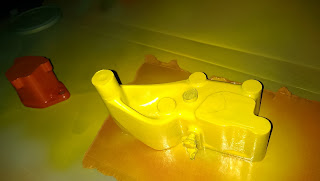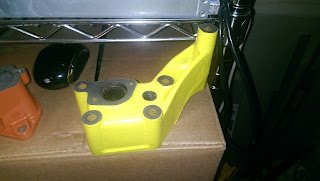Since buying Rhapsody, I've only ran the engine a total of around 10-15 hrs. With a disconnected hour meter showing 716 hrs., Total engine hours is around 730-740 hrs. Everything seemed to work fine with it, mostly. There were times it would have a sluggish start. I figured it was because I needed to bleed air out of the lines...
As they say with boat work, it'll take twice as long and cost three times as much. Well, in this case, it holds true as this took a LOT longer than expected. Just remember, with what you're about to see, was a working engine when I pulled it out.
I originally planned to change out a few rubber hoses, replace zincs and clean up some rust. As I started to take things apart, I discovered something else that needed some work and that cascaded into somewhat of a rebuild. Not a lot of space on the boat to do this kind of work. I drained the oil then I started taking a few things apart that I could take back to the house to work on when I wasn't visiting the boat.
 |
| Flywheel after transmission was removed |
Started off taking the head, starter, and transmission off. At the house, I continued dis-assembly of the head, laying out all the parts to keep track of where they go. This stage brought on all kinds of new discovery. This engine, while it worked, probably could have died at any time. This was not well taken care of in the past. Rust, mineral deposits, carbon build up, and more. One of the studs holding the exhaust mixer was so rusted through, there was no effort to break it off when trying to loosen the nut.
 |
| difference between old and new exhaust mixer |
The water ways were well built up with deposits. The cap that holds the zinc on the head wouldn't come off, so I took the whole cover off with some difficulty and found out it was so built up, it was completely blocked, nothing left from the zinc, and the deposits were holding onto the cover tightly. There was plenty of deposits by the thermostat housing too. You could see the layers as if it were the Grand Canyon. It took a LONG time to get it built up like that.
 |
| Zinc cover |
 |
| thermostat cover is green |
 |
| behind thermostat |
 |
| backside of thermostat housing |
 |
| Front size of thermostat housing |
 |
| valve condition |
 |
| piston condition |
In addition to these pictures above, there's also plenty of rusty areas to go around. I have various wire brushes either for a dremel or for a drill to get those parts cleaned up. While I have these parts at the house now, I plan to get the rest of the engine off the boat to bring to the house to continue the rebuild. I'm also putting together a shopping list that will go into the rebuild. Lots of gaskets, hoses, pipes and more.
8 January, I got the marina owner and one of his workers to help me out getting the rest of the engine off the boat and into the back of my truck. Started to clean off the top of the head and carbon off the pistons. They were starting to look better, but found out an issue with the aft piston.
 |
| front piston |
 |
| aft piston, with a nice crack in it |
Since finding a crack in the piston is a fairly major issue, that means more things are coming apart and more parts need ordered.
For the time I'm working on the block, I placed the engine on a furniture dolly that I can wheel around as needed.
I got both pistons out. The forward one wasn't too bad. Just a bit of carbon buildup above the first ring but that looks like it would be considered normal for a piston. The cracked one I took out first though. When I first looked down the side, I thought the crack only went down to the first ring but then I noticed a crack between the first and second ring that ended up being a broken piece. I then noticed the crack went down to the pin opening that holds the piston to the connecting rod. The crack could also be seen from underneath. One person told me he is surprised that there was still any compression in that cylinder with how this piston looks. Both will be replaced so they start off with the same wear on them.
Lots of issues found on this engine. Some surprising and some expected.
-----
Cleanup phase
With all the deposits that have built up in the water ways, I looked into how to take care of it. I came across a product called
Rydlyme. Other boaters have used it to run through their engines or heat exchangers to clean things out. I decided to order a couple gallons of it and tested it out on a couple smaller pieces.
So that picture of the thermostat housing above shows the first piece I decided to try out. After about half an hour, it looked like this.
After some additional cleaning with the dremel wire brush, it looked a whole lot better. I was even able to get the temperature sender off, with lots of effort. Let's say a 2x4 was very helpful to get that thing off. Here's how it looked. The wet part was degreaser as I'm still working to clean it up at this point.
Another small piece was the zinc cover, as pictured above, it was heavily blocked and actually took longer for the Rydlyme to dissolve the build up. After a while, I was mostly satisfied with how it turned out and went to using the dremel again to get the hardest stuff off of it. At this point, I still couldn't get the cap off that the zinc was screwed into, but still, the Rydlyme made a BIG difference.
After dipping the head, the waterways came out nice and clean after a couple hours of soaking.
 |
| used lapping compound for a better seal |
 |
| valve condition greatly improved. |
Dropped off the cylinder head on 4 Jan, and picked it up a couple days later. I only had them do a hot tank cleaning and worked on the valve surface. I didn't have them smooth down the exhaust side. I figured I could try doing that part myself. The guy at the shop said I could try using JB Weld to fill in the pitting.
This thing really looks good now.
At this point, I started to clean up the exhaust port. I did a little sanding with 80 grit sandpaper just to see that there was an even surface with the sides. Next, I got some JB Weld, recommended by others, to fill in the low spots where it could be sanded down for a smooth surface where the new exhaust mixer and gasket will get a tight seal. After I sanded the JB Weld, I saw there were still some low spots, so I did another mixed and laid some more on top to fill it in.
 |
| sanded |
 |
| JB Weld applied |
 |
| Sanded smooth |
-----
Finishing phase
Started doing some painting on a couple small pieces at first. The paint I used is VHT Engine Primer and Paint Enamels from Autozone. These are rattle can types that I've read good things about. I wanted to paint the engine a brighter color, so decided to paint it yellow. Then thought a few other items could be painted a contrasting color and went with orange for those pieces.
Started off with the air intake fitting that connects to the head. A few shots of grey primer then a few shots of the top coat of orange.
The thermostat housing is part of the head and the rest of the engine, so that got coats of yellow.
 |
| Thermostat cover |
 |
| backside of thermostat cover |
 |
| Air filter housing |
Still a few more pieces that need some work but they can wait for now.
-----------------------
Reassembly
 |
| Rocker spacing setup completed |
 |
| matching the orange with the oil filter was completely unintentional |
Below pictures show the engine, mostly completed, mounted on 4x4's and just about ready for testing.
And, as of 26 March, the engine runs again. But I'll reveal that in the next post. :-)
Now, it'll be ready for the boat once I have a new fuel tank installed.


























































